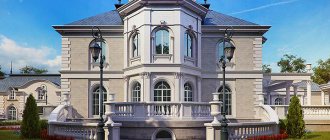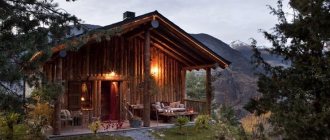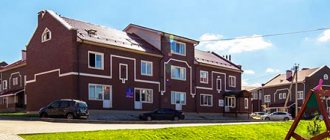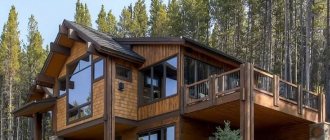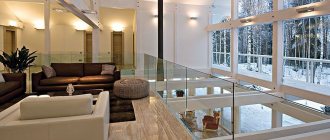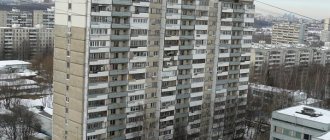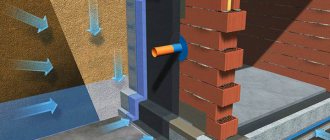Living in a private house promotes closeness to nature, and the presence of a balcony or terrace in it allows you to enjoy beautiful views and spend leisure time for your own pleasure, regardless of the season.
The appearance and design of these structures depends on the area of the house, the preferences of the owners and the architectural style of the building. If you are lucky enough to take part in the design of your own home, you can take advantage of expert advice, take into account all the nuances in advance, and make your own adjustments.
Both the balcony and the terrace are non-residential premises: they are equipped, first of all, to organize leisure time for residents and guests. Therefore, in this article we will jointly consider their features, advantages and disadvantages.
Open balcony in a private house
Balconies and loggias are integral elements of modern residential buildings. When properly designed, they become an excellent place for a comfortable rest, exciting pastime, conversations, and romantic evenings. The selection of finishing materials, furniture, accessories, the use of design techniques - all this helps to create the necessary atmosphere, regardless of the size of the available space.
Where does the redesign of an open balcony begin?
The process of decorating a balcony space should begin with a thorough cleaning of the area and assessing the condition of the facade. Cleaning involves removing unnecessary, old things. Inspection of the facade is necessary so that after completion of the work, the pastime will be comfortable and cozy. Therefore, if there are defects, it is advisable to eliminate them during the re-registration procedure.
The scheme of subsequent actions is determined by the type of balcony structure. The most commonly used concrete systems are characterized by high strength, durability, and endurance. But wooden systems are also often found, in particular in houses built from such material. When professionally performed, they have equally impressive characteristics.
The canopy also requires attention, without which it is difficult to imagine an open balcony. Since the presence of a visor provides protection from rain, bad weather, and hot sun. It must be larger than the balcony itself and installed at a certain angle.
Features of wooden structures
The load-bearing elements of a wooden structure are beams. Their cross-section should be 10x20 cm. During construction, it is worth remembering that the beams should be fixed in the wall no more than 25 cm deep. If this rule is not followed, the balcony may not withstand the load acting on it. All beams should be located at a distance of no more than 80 cm from each other.
The supporting elements are fixed to the wall with metal corners or strips. In this case, it is necessary to install racks under them. After completing such work, the longitudinal beams are secured. They are created from boards with a section of 5x10 cm. They must be installed at a distance of about 30 cm from each other.
To make the structure more rigid, it is worth creating grooves about 30 mm deep in the beams. The floor on the wooden extension is created from boards 4 cm thick.
Fences are best made from boards with a section of 3x13 cm. All structural elements are secured using screws and nails. It is worth remembering that all wooden structural elements must be coated with a protective composition, since due to constant exposure to moisture, the balcony can change greatly over time.
The importance of choosing the right materials
Attractive balconies can be designed both in an apartment and in a country house. Of course, there are many more possibilities in cottages. But even a small area can be made as functional and ergonomic as possible. In any case, the final result will depend on the selection of building materials.
These must be products designed for use in harsh conditions, able to withstand temperature changes, moisture, and exposure to sunlight. Building materials that will be used for work on the south, sunny side require special attention. They must be resistant to fading and ultraviolet radiation.
Flooring options for an open balcony
When decorating an open balcony, it is important to install the flooring correctly. The durability and attractiveness of the finish in the future largely depends on this. Regardless of where the work will be carried out - in a country house or in an apartment, it is recommended to ensure a slight slope of the base.
It may be completely invisible, but it will avoid the accumulation of moisture and subsequent destruction of the coating. As a base, it is recommended to make a screed that is suitable for further installation of almost any material. Sometimes design features require searching for other solutions.
Among the finishing options used, the best characteristics are:
- Porcelain stoneware is an incredibly strong and durable material that attracts with its best properties. Exceptional resistance to destruction and various impacts is determined by the structure. The absence of pores prevents moisture penetration and subsequent destruction. When decorating a balcony in a private house, it is better to choose a product that meets certain operating conditions and has a non-slip surface.
- Tiles provide a more affordable, but no less impressive and practical solution. Selection for an open balcony should be made taking into account the weight of the product, frost resistance, and ability to withstand loads. A non-slip surface is required.
- Self-leveling flooring helps create a uniform, high-quality coating. Here you cannot make mistakes in performing the work. This will affect durability and results.
- A balcony in a private house, like a terrace, is often decorated using decking boards. The latest production technologies and special processing guarantee the durability and attractiveness of the coating on the open balcony. This solution is indispensable for wooden balconies, when you want to make the structure as light as possible.
Other flooring options
Work on finishing open balconies is accompanied by the use of other materials. Applicable:
- linoleum;
- dye;
- It is possible to choose a mat, for example, artificial grass.
But each case has its own subtleties. Linoleum often does not withstand harsh operating conditions and is destroyed when exposed to frost. The choice of paint involves repeating the finishing work in a few years. The paint coating will last up to four years with proper preparation of the base.
Selection of materials for wall decoration
Cottages often have a balcony above the veranda. Such a solution allows you to further decorate the facade of the building, making the appearance complete and more attractive. Here you can even use various accessories and decorative elements, selected depending on the existing finish. Accordingly, wall decoration requires no less attention.
Since the balcony will be open, the building materials selected should be intended for outdoor work. That is, they must be durable, resistant to various influences and pollution. Taking into account all the requirements, experts recommend choosing the following products:
- Porcelain tiles and tiles represent a group of the most durable and attractive materials with excellent properties. The conditions for maintaining the original indicators are the choice of products of a certain class that correspond to the expected loads on the open balcony.
- Siding and lining are an excellent option for decorating a balcony space. Their wear resistance, safety, and stylish appearance are important advantages. When decorating an open balcony, it is advisable to use metal structures for lathing.
- Plaster is a product characterized by a rich palette of shades. For work, it is worth choosing decorative plaster, which contains special substances that maximize useful characteristics.
- Paints for use on open surfaces must be abrasion resistant. It is worth giving preference to weather-resistant products.
Before finishing finishing work, it is necessary to prepare the walls. For this, special primers are used. Mixtures are selected taking into account operating conditions and materials that should be used for the final finishing of the open balcony.
What kind of base to make
The type of foundation will depend on two fundamental points:
- weight of the structure;
- soil conditions under the selected site.
Most often, verandas are lightweight frame structures made of wood. This is due to the following reasons:
- relatively light weight;
- low sagging deformation, which allows you to install fewer support points than a steel beam;
- low temperature expansion;
- long service life (when treated with protective compounds).
A massive extension is sometimes placed on a strip foundation, but the best option would be one of the types of pile foundation.
Columnar supports
On stable, dry soil, the local area, previously covered with concrete, is treated with adjustable supports that are placed under the logs of the veranda.
Their load-bearing capacity (1 t), the design adapted to adjustment, makes it possible to set the horizontal plane even in the presence of some uneven soil. On the same basis, expanded clay concrete blocks and concrete pads are used to raise the site to the required level. They are positioned at reference points in increments of 0.4 - 0.5 m. Condition - the block must be solid, concrete with moisture-resistant additives.
If the soil is heaving or mobile, a pile and columnar type of foundation is used. The pile can be screwed in (easy way) or made of brick, blocks, rubble stone, asbestos-cement pipes and filled with concrete.
Considering the lightness of the structure of the terrace and the balcony above it, the number of pillars can be reduced by supporting the platform on the foundation of the main building. This decision must be confirmed by calculation. Otherwise, maintain a distance of at least 3 cm.
Security systems for buildings with open balconies
When decorating a space, you should think not only about how to protect the open balcony from bad weather, rain, and other environmental influences. An open area like this may attract unwanted visitors. Therefore, even during design development, it is worth considering the need to protect open space from burglars. There are several effective solutions here:
- Installing forged grilles will allow you to maintain the naturalness and airiness of the space, preventing the entry of uninvited guests. Various decoration options will allow you to make such an element a real decoration.
- The choice of armored doors mounted in place of balcony doors contributes to the organization of reliable protection. They have an attractive design and a very powerful, reliable design that prevents the possibility of penetration. It will be extremely difficult for robbers to open them thanks to the reliable configuration. High resistance to burglary is noted.
- Security systems are designed to protect objects at all times. Depending on the available functions, they can simply scare away intruders by turning on the lights and sirens.
When organizing a security system in suburban areas, comprehensive solutions are selected that involve the use of sensors, various devices, and cameras. All this helps prevent the possibility of penetration into the site itself. And if robbers do manage to get inside, such systems will help carry out the investigation much faster.
An integrated approach to organizing the security process indicates that the owners take the security of the facility seriously. This is also a guarantee of peace and safety of valuables and property located in the house.
Link to article
To take a break from work, you don’t have to leave the city or go to the park. If your apartment has an open balcony, it’s time to arrange a summer veranda on it - for relaxation and tea with friends.
If the balcony is the most unused part of your apartment, it's time to change something. Even the smallest balcony in a Khrushchev building can be turned into a cozy green corner: you don’t need a large budget for this - if you have the desire.
GET RID OF UNNECESSARY THINGS
We will assume that these unused meters of balcony or loggia are your personal plot on which you will arrange a gazebo or veranda. First of all, you need to remove everything that interferes with further registration: old shoes, some boxes of household appliances, pots that you will no longer use, bags of unknown things and unknown when and by whom. Free up as much space as possible.
CHOOSE A DURABLE FLOOR COVERING
As a result, you should be left with the original structure that the architects came up with for your apartment: a balcony door with a window, the balcony space itself, its fencing. The first thing you need to think about is the floor covering: it must withstand different weather conditions and be easy to clean. Wooden flooring is what you need to update the floor on your balcony. Moreover, you can definitely handle laying garden parquet yourself. You can also use deck boards and linoleum.
DON'T FORGET ABOUT WALL FINISHING
To decorate the walls of a summer veranda, choose materials that can withstand both bright sun rays and rain. You can keep the existing brickwork - it's fashionable now. But it is better to cover concrete walls with plastic or wooden panels - here you will need a special anti-mold compound. If you choose paint, choose acrylic - it is not afraid of moisture and sunlight.
DECORATE THE GRILLE
Balcony railings can be either reinforced concrete slabs or open metal balustrades. To prevent nondescript grilles from being noticeable, they can be covered with a bamboo mat or thick textiles. But the safest and most durable option is glass or plastic screens. They can be installed not only on gratings, but also as a partition between yours and your neighbor’s balcony.
EXPAND YOUR VERANDA SPACE
Since you cannot increase the area of your future green veranda at the expense of other rooms, rely on the “visual expansion” of the space. Go beyond the designated “rectangle”: for example, you can install long flower pots on the outside of the fence or fix wide window sills along the perimeter of the balcony.
BET ON VERTICAL GARDENING
Flowers are an indispensable attribute of the summer veranda on the balcony. They will add coziness and create a pleasant atmosphere. To prevent numerous pots from occupying an already small area, rely on vertical gardening. Use high racks, shelves, shelves and hanging structures for pots for this purpose. Pansies, marigolds, Turkish carnations, fuchsia and pelargonium are perfect for a summer balcony.
INSTALL FURNITURE FOR THE GAZENAU
There are no strict rules here. You can purchase and use special furniture for gazebos suitable for open balconies - it will withstand both heat and humidity. Keep in mind that a nice soft chair will need to be brought into the room every time it rains, but metal tables for tea parties are not afraid of anything. If you like to sunbathe, you can take a soft, modern cot to the balcony.
ADD A LITTLE DECOR AND TEXTILES
Any decor will be in place on the veranda balcony. And some decorative lantern that can be hung above the window, and an interesting piece of driftwood from the forest, and a Scottish blanket for an armchair, and an antique coffee pot with cups - you are limited only by your imagination. Pay attention to whether things combine with each other: it is better to group them by style or color.
THE FINAL TOUCH – LIGHTING
Lighting fixtures are the finishing touch to the design of a summer veranda on the balcony. LED garlands, solar-powered lamps and candles in closed candlesticks will do an excellent job for this purpose. Feel free to bring your ideas and ideas to life.
Balconies and terraces in private houses and cottages: views, projects, design on the Nedvio website
Living in a private house promotes closeness to nature, and the presence of a balcony or terrace in it allows you to enjoy beautiful views and spend leisure time for your own pleasure, regardless of the season.
The appearance and design of these structures depends on the area of the house, the preferences of the owners and the architectural style of the building. If you are lucky enough to take part in the design of your own home, you can take advantage of expert advice, take into account all the nuances in advance, and make your own adjustments.
Both the balcony and the terrace are non-residential premises: they are equipped, first of all, to organize leisure time for residents and guests. Therefore, in this article we will jointly consider their features, advantages and disadvantages.
Veranda and veranda - 3 different concepts in one word
Beautiful combination of glassed veranda and balcony
For some reason, it so happens that construction and architectural concepts are often confused with each other, and although they are close in design, they are by no means synonymous. First, I want to say that I will adhere to general concepts that are often perceived by the vast majority of the population; many do not see the difference between a veranda, a terrace and a balcony.
However, I will still explain the real meaning of these words and also show a video in this article.
Do you need a balcony?
Conventionally, all owners of suburban housing can be divided into two categories: the first - those who consider the presence of a balcony to be a mandatory attribute of their home, the second - those who are not ready to sacrifice extra square meters for the sake of a panoramic view.
It would seem that what’s wrong with a balcony? Opponents usually give two arguments for this:
- Typically, a balcony in cottages is located on the second or attic floor, and occupies some area of the house. This means that the rooms will be smaller than they could be.
- In addition, there is not always something to see from such a site (this is especially true for small areas): there may be a neighboring cottage, a road, a construction site, etc. close to the house.
Canopy installation
To install the visor, you should prepare the following equipment:
- a welding machine with which the frame will be formed;
- screwdriver;
- perforator;
- hammer;
- roulette and level.
During work you will often need a construction marker.
There are several stages of installing canopies:
- First you should mark the fasteners. In these places holes are made for dowels. It is necessary to set the horizon and the level of placement of the structure.
- Holes for dowels in the frame elements are made with a drill.
- The frame is fixed by clamping the anchors and tightening them with keys.
- Between the load-bearing elements, stiffeners should be placed, which are made from the same profile pipe. They can be welded or bolted.
- Once the base is installed, construction of the roof can begin. It must be attached to the stiffeners. Self-drilling screws are used for this.
These features of canopy installation will be useful when building a full-fledged balcony.
Deciding on the design
Even if the balcony does not carry a special functional load, it is always perceived as a decoration of the facade. In the old days, balconies were used precisely for this.
Classic style
Classic implies the presence of clear shapes, strict geometric compositions and the absence of unnecessary details. A classic balcony is decorated with rounded arches and two supporting columns.
As a rule, such a balcony is not overloaded with furniture and is decorated with flowering plants.
Modern style
Modern trends in design inspire owners to build a house in the Art Nouveau style. Such buildings look minimalistic and functional. They are characterized by decorating the façade with a spacious terrace.
To have access to this room in winter, the area is glazed. Panoramic glazing looks impressive and allows you to contemplate the beauty of the environment without leaving your comfort zone.
On the Art Nouveau style terrace you can place a set of upholstered furniture, a table and other interior details. the open area can be located either on the ground floor or above.
Scandinavian style
Balconies are often found in Scandinavian style. These are cozy rooms with a focus on minimalism. This design features a large glass area on the walls in front of the balcony. To ensure that less noise from the street enters the house, additional insulation is used during construction.
The use of natural wood and stone makes such balconies very comfortable and warm. Glazing is generally not practiced.
This type of design is best suited for wooden houses in the Scandinavian, Finnish, and Canadian styles. It is allowed to add additional eco-design elements to the balcony design to emphasize individuality.
Roof with frame independent of glazing
Glazing of balconies with a roof is often a necessary measure when finishing a balcony on the top floor, or in a house with alternating balconies between floors.
will install you a roof of any type and design, including the most modern and practical roof for a balcony today - a roof with a frame independent of the glazing.
A glazing-independent roof frame is not connected to the glazing support, but instead is simply attached to the wall of the house, avoiding load on the balcony.
With complex glazing of a balcony with a roof, we can install a roof with the balcony removed, as well as carry out any work on its arrangement.
We also produce another lightweight type of balcony roof made from wooden blocks. This type is more economical and easier to install. But such a roof on a balcony requires additional support; usually, the support is the balcony glazing frame itself.
There is also an intermediate version of a roof for a balcony with a support made of metal posts . The frame of such a roof is made of welded corners, and the edges rest on parapets using metal racks made of a profile square pipe. Typically, this type of roof is installed on a balcony if the roof overhang from the facade of the house is of impressive size.
Roof with independent glazing and frame made of corrugated sheets
Roof on balcony on racks with support
Balcony canopy made of polycarbonate on racks with a new parapet
Source: moskov-balkon.ru
Criteria that a balcony and terrace must meet
Most owners of country houses have a rather narrow idea of what these premises should be like. In order for these façade details to be useful, they must meet the following requirements:
Be functional
Think about the purpose of the open area in advance so that later it is not empty and does not cause your disappointment. If your home already has a non-functional balcony or terrace, they can be modified and adapted to specific needs, for example, turned into a flower greenhouse or equipped with a workplace.
Be safe
In pursuit of additional square meters, some owners add balconies to their houses. As a result, this unauthorized construction is not used due to its instability or simply disfigures the façade of the building.
Look harmonious
The balcony should be decorated in the same style as the entire facade of the cottage with the maximum use of identical building materials. If the house itself is covered with wooden inserts, and the terrace is covered with plastic, then such a building will look awkward.
Constantly used
If you don’t feel comfortable going up to the balcony to drink your morning cup of coffee, consider installing a terrace on the porch of the building. This option is often used in Canadian and American style homes.
The lower balcony will also be convenient for those who prefer to maintain privacy or cannot enjoy the beautiful view from the upper floor.
Where to place the extension
Most often, a balcony is created above the entrance, since this part of the house is directed towards the street. But it is worth considering that this is far from the best option, since privacy is necessary for a good rest. It is best to place the extension on the back side of the house. If a beautiful garden has been created near the building, the balcony should be directed in its direction.
Before creating a design, you should consider the negative points:
- the cost of creating a house with an extension is significantly higher than without it;
- creating a balcony leads to an increase in heat loss;
- complexity of creating a design.
Before starting work on creating an extension, you need to decide whether it is needed or you can do without it. First of all, the house must be functional, so in some cases the balcony should be abandoned. It is worth remembering that a balcony cannot be created on the flat roof of a house.
Options for planning a balcony in a private house
The design of a balcony or terrace involves creating a cozy space for relaxing and receiving guests. Many people forget about this function and clutter up the useful space with clothes dryers and drawers with unnecessary things. If you have already done this, think about how wonderful it is to have a separate room, quiet, surrounded by fresh air and pleasant things.
If it is not comfortable to be on the balcony, take care of the glazing. If the railing structure blocks the entire view, replace it with transparent panels.
The same goes for visors. By the way, thanks to modern technologies, it is possible to create very beautiful, airy glass canopies and canopies over the terrace, which are in no way inferior in strength to metal or concrete ones. You can learn more about this technology here.
Design experts also recommend combining an isolated panoramic balcony or terrace with an adjoining room. This way, you will expand the space and will go onto the balcony more often, and adapt the freed space to your taste. One option: organize a study, a soft corner, a greenhouse or a play area.
How we make a roof
ATTENTION! When choosing a roof on the balconies of the last floors, it is important to take into account wind and snow loads, as well as the type of glazing of the balcony. Incorrect and independent design can lead to dire consequences! Entrust the design and installation of your roof to professionals right now!
Of course, choosing the type of roof is not everything; the next step is choosing the roof decking.
offers the following roofing options for balconies on the top floors:
– Corrugated sheet is a galvanized steel sheet, which has extensive production and application in the field of construction and repair. A huge number of color solutions for corrugated sheets allows you to create an aesthetic and beautiful look for a balcony or loggia. The disadvantage of this material is increased noise generation.
"Khrushchev House"
"Stalin's House"
Color solutions for roof decking on balconies made of corrugated sheet material:
– Metal tiles – characterized by increased material strength due to a multilayer polymer coating. Therefore, a roof made of metal tiles will serve for a long time and with high quality in any climatic conditions. The disadvantage of the material is increased noise generation.
"Khrushchev House"
"Stalin's House"
– Keramoplast is a rigid and environmentally friendly roofing material produced in Russia since 2000. It has exceptionally high strength and durability. The main advantage of this roofing is the sound absorption of all external sounds.
"Khrushchev House"
"Stalin's House"
Why should a roof for a balcony be ordered from?
- Consultants will help you, over the phone, navigate correctly with the choice of roof type and will calculate the order.
- We purchase material for our balconies only from direct brand manufacturers.
- Each of our employees who installs the roof has a passport and permission to carry out the work.
- For 12 years, our company’s specialists have been engaged in professional and mountaineering work on the top floors of residential buildings.
- Thanks to specialists of the first category, we can provide a high guarantee on work.
- Only our managers will be able to draw up for you a detailed project and plan for your future balcony roof, which will serve reliably and for a long time.
- Only we! We will install the roof in 1 DAY!
And all this to ensure that your balcony is always clean, cozy and serves its intended purpose!
Order a manager to take measurements to draw up a balcony roof project for FREE!
Source: sbalkonom.ru
Balcony projects for houses made of different materials
There are various combinations of arranging a balcony or terrace area:
- A structure with an open area can be attached to the house, creating a base of several columns;
- A terrace can be built on the roof of a garage or utility room attached to the house;
- Terraces at a low height are usually placed on a pedestal near the porch or arranged directly in the garden, as a separate island for relaxation.
The material from which the balcony is made must be in harmony with the façade material in its color and texture. Thus, the result is a composition that complements each other and looks more solid.
During the design and construction of a cottage, you can provide for the presence of a built-in balcony. In houses made of foam blocks, they are placed inside the building, which is due to the increased hygroscopicity of the material. Such buildings require additional waterproofing and glazing. But there are a lot of options for external cladding of the facade.
In wooden houses in the Russian manor or country style, a balcony is usually added. It stands out against the background of the building and does not close. The advantage of this type of balcony is its openwork design and the use of environmentally friendly materials.
Frame cottages provide a variety of options for arranging terraces and balconies. They can be glazed, remote or built-in. It all depends on the design of the house and the stage of construction.
To ensure that your balcony meets all practical parameters, take into account the climatic features of the area and do not forget that frame construction requires the use of lightweight structures. Therefore, in some cases, a balcony may need supports.
Roof terrace of an apartment building
Engineers began to design some projects of apartment and multi-storey buildings in such a way that residents would have some of the advantages of country houses. Large apartments may have their own terraces instead of the usual balconies.
Others equip a common recreation area on the roof. This option is also attractive because the roof of any high-rise building can be rebuilt. Such projects require serious preparation, qualifications, construction work and high-quality materials.
Not every high-rise building can support such a recreational area. The foundation, supports and supporting structures must be designed or reinforced for such loads. In order not to make the structure heavier, you should make do with light wooden materials, boards and timber. You should also choose the simplest, most durable furniture that is easy to care for.
For greater immersion in the atmosphere of nature, the floor should be laid out of wood, and the terrace should be filled as much as possible with unpretentious plants such as moss, ferns, and dwarf coniferous shrubs.
Such a rooftop park is very attractive not only in expensive hotels. A common recreation area promotes communication and getting to know people, because people often don’t even know the names of their neighbors.
Any large-scale work should be started if you are sure of its necessity, because it will require a lot of effort, time and money. Verandas and balconies are a good place for rest and relaxation. But they also require maintenance, so it is necessary to weigh the resources spent with the benefits brought before starting work.
Features of fastening balconies
We are all accustomed to urban-type balconies - these are small protruding platforms. This type of fastening is called cantilever. The load-bearing plate is mounted into the wall and can be secured with additional supports from below.
This type of balcony must be provided during the construction stage of the house. If this point was not taken into account, you can install an independent attached balcony. It does not carry additional load for the facade and is secured using special supports.
You can make a balcony with your own hands. The most budget option is to use natural wood and attach it to the wall with metal anchors. If the balcony is heavy, it is important to have additional supports. The small area of the attached balcony can be compensated by the terrace on the lower floor of the house.
What could your terrace be like?
Designing a terrace does not require special knowledge or high costs. The most important thing is to make a small free-standing or wall-mounted platform. If necessary, you can decorate it with railings, shrubs and equip it with a canopy roof that will protect it from sunlight and rain.
The most popular material for a terrace is wood. If you choose this option, do not forget that wooden structures need regular treatment with special materials against pests and protection from moisture.
On the terrace you can install a soft corner, a set of moisture-protected garden furniture, and a dining table. Ready-made terrace decor can be found in hypermarkets that sell garden furniture. There you will be inspired by interesting ideas. For a pleasant pastime and tasting delicious dishes prepared in the fresh air, you can buy and install a grill system.
Use your personal needs to determine the area of your terrace. For example, to place a chair or chaise longue with a small table, 2 square meters is enough. m. area, but the dining table and barbecue area will require much more space.
Imagine and make good use of the area of your balcony or terrace. Remember that for outdoor recreation in the summer, you can equip an open area on the ground floor, and for winter you can have a glass balcony upstairs. In any case, it is better to take into account all the nuances of the layout at the design stage of a private house.
Did you find this article helpful? Please share it on social networks: Don't forget to bookmark the Nedvio website. We talk about construction, renovation, and country real estate in an interesting, useful and understandable way.
balcony over veranda
Question asked:
lalarissaa
Good afternoon We are attaching a veranda to the house (tree), above which there will be a balcony. At the moment, a similar structure exists, but due to its disrepair it was decided to demolish it. We kindly ask you to look at the weak points of our project or offer your own))) And then separately estimate the required amount of material (and, or the price of it) The new balcony (and veranda) will be 3 m wider (the current one is 1.2 m), the roof of the veranda will be an exploitable roof-balcony. We dig separately for the foundation and tie it to the foundation of the house. The design of the veranda-balcony itself should not “hang” on the house. The size of the veranda-balcony is 3m*4.5m with a height of 3m. We planned metal pillars with a cross-section of 100*100, four pieces of 3m each, very dense lathing and galvanized painted corrugated sheet. Because the balcony is along the entire width/length of the veranda, cut holes in the corrugated sheet for joining (by welding) the balcony posts (pipe 100*100) with a height of 100 cm. You may need an additional post, because span 4.5 m? The floor of the balcony is a dense wooden lattice on corrugated sheet.
Features of forged structures
These designs are quite beautiful, but require a large investment. There are several things to consider during installation:
- Before installing the gratings, you need to make sure that the base plate is secured securely enough, since metal products are heavy;
- the grate should be installed only after the concrete has completely hardened (if a ready-made slab is not used);
- to restore the concrete slab of a wrought-iron balcony, you should not use cement-sand mortar, as it will quickly fall off;
- To get rid of small cracks, you should add tile adhesive to the solution.
The creation of a forged balcony occurs in the same way as the construction of a concrete structure, but instead of supports, forged elements are fixed.
Comments
It won't work as you suggest doing :). The fact is that now your canopy is “fastened” to the house, which ensures its stability. The house keeps the balcony from shifting. When you make a 3m balcony, your house will no longer be able to provide good support. It will just curl up like a screw. To prevent this from happening, it is necessary to make either rigid nodes in 2 directions, or place them in one of the communication directions. Connections will not suit you; they will interfere. Therefore, it is better to make struts.
Above I have attached a picture with the minimum required elements. This is despite the fact that the balcony will be “fastened” to the house. This does not mean that the balcony will hang on the house. The house will just hold him. If this is not done, then struts (green) must be installed on all sides.
Pipes with a diameter of 100 mm are suitable as racks, but it is advisable to take a wall thickness of more than 5 mm; these cannot be burned through welding and will last longer. In terms of strength, 3mm is enough. But pipes are no longer suitable as main beams (yellow). It is advisable to take a channel. Moreover, at 4.5 meters you need at least No. 18. A frame is made from the channel along the contour (as in the picture). Plugs 6-8mm thick are placed on the top of the columns (square plates are 1cm larger than the pipes in each direction). The plugs are welded to the pipes so that there are no gaps - they will protect against corrosion. After aligning the columns, a frame is placed on top and welded. The frame is pulled to the house with pins, but there is no need to tighten it too much. To do this, you can lay boards or something similar between the house and the frame. Studs with a diameter of at least 12mm (4-5 pieces in length).
The struts can be made from the same channel or 90x6 corner. Fasten to each other through gussets (plates 6-8mm thick). All welds must be at least 60mm long. It is advisable to make the seam legs according to the minimum thickness of the parts being welded, but it can be the same everywhere - 5 mm.
All that remains is to fill the frame with something. I would recommend boards 50x150(h) mm with a pitch of 600mm. On which to make wooden flooring from 40mm boards. Remember to make a slight slope so that the water drains quickly.
It is also possible to make a monolithic floor using a profiled sheet, but then the cross-sections of the metal elements must be increased.
PS Check the construction area, balconies are quite heavily loaded with a conventional “useful” load according to the standards, but in some areas the load from snow is greater

